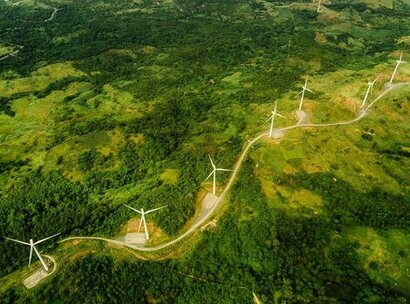
Brand-new digital service ReWind aims to address the challenge of sustainably decommissioning the thousands of wind farms built around the world from the 1970s onwards which have now reached the end of their life. This is currently a key issue for the wind industry.
Presently, most decommissioned wind turbines are buried underground, for lack of a better solution. In 2020 Bloomberg highlighted the situation in Casper, Wyoming in USA, where 870 wind turbine blades are buried under a landfill. WindEurope estimates that 25 thousand tonnes of wind turbine blades will have to be recycled by 2025, and 52 thousand tonnes by 2030.
DNV‘s specialist team analyses and develops reports for wind farm owners and operators, showing, among other things, which materials the wind turbines contain, how they can be disposed of in the best possible way, what can be recycled and how. Now, in collaboration with Reodor Studios, a Norwegian corporate venture and innovation studio, DNV will shape this into a digital service.
“This service will enable wind farm owners to quickly assess turbine recyclability percentage and options, end-of-life planning, and sustainable decommissioning” said Matthew Geraghty, Founder and ReWind venture lead at DNV.
The use of wind energy will grow, and with that, the need to replace older turbines and equipment to keep pace with developments. Indeed, DNV’s 2022 Energy Transition Outlook report forecasts that by 2050, wind will provide almost 50 percent of on-grid electricity in Europe, and 40 percent in North America and Latin America. New turbine types and bigger turbines, blades, and towers will raise capacity factors for onshore wind from 26 percent now to 34 percent and from 38 percent to 43 percent for offshore wind by 2050.
“This is the first time in history that we have faced such a challenge” said Lucy Craig, Director Growth, Innovation & Digitalisation, Energy Systems at DNV. “A wind turbine has a life cycle of around 20-30 years, and now many wind turbines are approaching the end of their life cycle. Today, the process of recycling and decommissioning these is extremely complicated and manual, and large quantities of wind turbines end up in landfills, for lack of better solutions. Introducing this digital service helps the owner plan for decommissioning, map costs, and assess recycling options.”
In order to create a digital service that meets all its customers’ needs, DNV has initiated a collaboration with Reodor Studios. By combining Reodor’s expertise in building digital products and services with DNV’s world-leading domain knowledge, the ReWind team can work faster, increase the chances of scaling successfully, and build a well-tested service that can make the process of decommissioning wind turbines smoother for wind farm owners and operators.
“Capital Dynamics Clean Energy is committed to responsible investment and ESG implementation throughout the investment lifecycle” said current customer of the service Gintare Briola, Head of Portfolio Management, CEI at Capital Dynamics. “ReWind’s recyclability study for our wind farms helped us gain a better understanding on the recyclability of the equipment, the existing and developing recycling methods, including for composite blade waste, and forecasted decommissioning costs. ReWind also provided recommendations for various stages of the project life cycle that we at Capital Dynamics hope to implement to minimize environmental impact and reduce lifetime emissions.”
The digitisation project is now ongoing, with the team working on validating market needs, developing a service concept, business model, and a scalable growth strategy based on customer insights.
For additional information:

